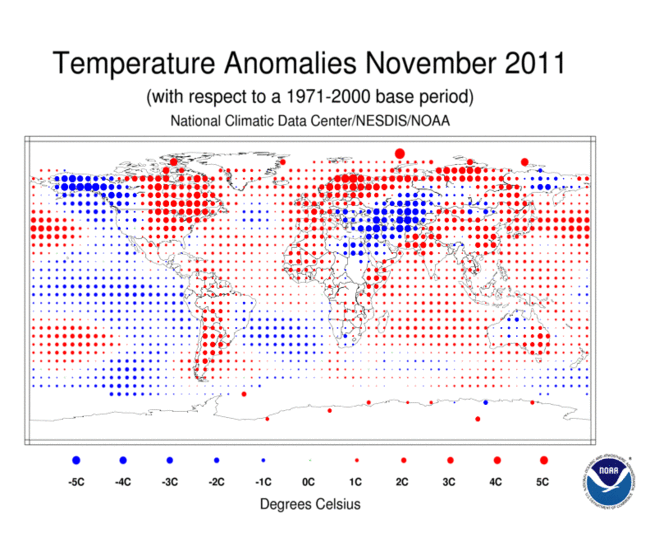According to the National Oceanic and Atmospheric Administration of the US the globe experienced its 12th warmest November since record keeping began back in 1880.
On top of this, Arctic sea ice extent was the third smallest on record at 11.5 percent below average, and La Niña conditions continued throughout the month and is expected to continue through the winter.

More highlights from NOAA’s National Climatic Data Center are as follows;
Global temperature highlights: November
- The combined global land and ocean average surface temperature for November 2011 was the 12th warmest on record at 55.81 F (13.35 C), which is 0.81 F (0.45 C) above the 20th century average of 55.0 F (12.9 C). The margin of error associated with this temperature is +/- 0.13 F (0.07 C).
- Separately, the global land surface temperature was 1.10 F (0.61 C) above the 20th century average of 42.6 F (5.9 C), making this the 16th warmest November on record and the coolest month since February 2011. The margin of error is +/- 0.20 F (0.11 C). Warmer-than-average conditions occurred across central and eastern North America, Northern and Western Europe, northern Russia, most of China and the Middle East, southeastern Australia, and southern South America. Cooler-than-average regions included Alaska, western Canada, much of Eastern Europe, Kazakhstan, and southwestern Russia.
- The November global ocean surface temperature was 0.70 F (0.39 C) above the 20th century average of 60.4 F (15.8 C), making it the 12th warmest November on record. The margin of error is +/- 0.07 F (0.04 C). The warmth was most pronounced across the north central and northwest Pacific, the Labrador Sea, and portions of the mid-latitude Southern oceans.
- November 2011 marks the 321st consecutive month with a global temperature above the 20th century average. The last month with below average temperatures was February 1985.
Global temperature highlights: September – November
- The combined global land and ocean average surface temperature for the September – November period was 0.94 F (0.52 C) above the 20th century average of 57.1 F (14.0 C), making it the 12th warmest such period on record. The margin of error is +/- 0.16 F (0.09 C).
- The September – November worldwide land surface temperature was 1.57 F (0.87 C) above the 20th century average, the seventh warmest such period on record. The margin of error is +/- 0.31 F (0.17 C). The global ocean surface temperature for the year to date was 0.70 F (0.39 C) above the 20th century average and was the 12th warmest such period on record. The margin of error is +/-0.07 F (0.04 C).
Global temperature highlights: Year to date
- The combined global land and ocean average surface temperature for the January – November period was 0.94 F (0.52 C) above the 20th century average of 57.2 F (14.0 C), making it the 11th warmest such period on record. The margin of error is +/- 0.16 F (0.09 C).
- The January – November worldwide land surface temperature was 1.51 F (0.84 C) above the 20th century average, the seventh warmest such period on record. The margin of error is +/- 0.36 F (0.20 C). The global ocean surface temperature for the year to date was 0.74 F (0.41 C) above the 20th century average and was the 11th warmest such period on record. The margin of error is +/-0.05 F (0.03 C).

Polar sea ice and precipitation highlights
- The average Arctic sea ice extent during November was 11.5 percent below average, ranking as the third smallest November extent since satellite records began in 1979. The extent was 502,000 square miles (1.3 million square kilometers) below average. This marks the 18th consecutive November and 126th consecutive month with below-average Arctic sea ice extent.
- On the opposite pole, the Antarctic sea ice extent during November was 0.5 percent below average, the 11th smallest on record. This is the first November since 2002 with below-average Antarctic ice extent.
- Northern Hemisphere snow cover extent was much-above average during November with the 4th largest November snow cover extent in the 46-year period of record. Both the North American and Eurasian land areas had above-average snow cover extents.
- Much of Europe experienced extreme dryness during November. Both Germany and Austria reported their driest Novembers on record. Much-wetter-than-normal conditions occurred across parts of South Asia and northeast Africa.
